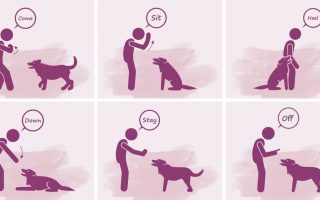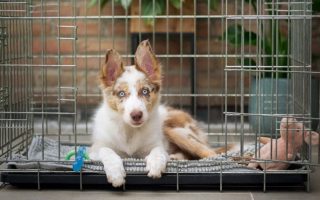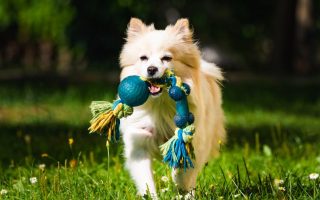If you’re in search of how to socialize an aggressive dog, read on to discover pro tips to help your canine socialize with other dogs and humans.
Few things are more problematic to pet parents than an aggressive dog. These dogs are harder to train and control.
They also leave a bad impression on the minds of those who don’t own dogs.
Some dog breeds like the American Pit Bull Terrier have been branded ferocious because of their aggressive tendencies.
In reality, even the most aggressive dog breeds, including dogs with high prey drive, can be trained
Most dog breeds are trainable once the owner has the skills to succeed in this.
The myth that all dogs are aggressive is unfounded and blinds us to the nanny good qualities of these canines.
Having said this, the statistics are a cause for concern.
A study done by the Center for Disease Control (CDC) has shown that approximately 4.5 million dog bites occur in the United States each year, and 800,000 of those bites result in medical care.
The study was done in 2019 when the US population was estimated at 328.2 million. Hence, 1 out of every 73 people in the US got bit by a dog in 2019.
What do you do if you have a dog who’s prone to aggression?
It is up to you to curb this habit.
While you may not completely erase this habit, you can reduce it, thereby preventing your beloved pet from turning into a societal menace.
Let’s look into different ways you can socialize an aggressive dog.
Aggressive behavior in dogs can be unexpected and disturbing, both to the owners and strangers.
It is saddening to see your lovely and friendly canine turn into a ferocious monster in less than a minute.
To properly understand aggression and how it can be curbed, you’d need an explanation of important concepts related to aggression.
That way, you’d have more clarity over what might be going on with your dog and the rightful solution for it.
The first concept to explain is aggression itself.
Aggression is a wide term that describes a set of undesirable—and wild—habits living beings manifest. In the case of dogs, these habits include:
- Biting
- Incessant barking
- Growling
- Snapping
- Scratching
- Lunging
- Chasing strangers
The preventive step to aggressiveness is socialization. Socialization is done by exposing a dog to different environments and strange people. It is done to get them used to novelty.
The best time to start socializing a dog is when he’s a pup. However, even adults can be socialized with some processes in mind.
Socialization may not curb all forms of aggression, however.
Hence, you should consult a vet or a dog consultant to determine the exact form of aggression your canine exhibits.
Socialization helps reduce fear-based aggression, which is the most common form.
Fear-based aggression tends to have triggers, which may be a single object (like men in a black suit or noise), or from various sources.
Dogs who get scared of many things have anxiety, and it is peculiar to some breeds. You must identify the trigger(s) of your dog.
From the explanations, it is clear that an aggressive adult dog still has hopes of being socialized.
This involves using methods like desensitization and counterconditioning.
With the former, you gently expose your dog to triggers until he becomes less scared.
Counterconditioning means reducing the fearful effect of the trigger with a reward.
The first thing to know about socializing an aggressive dog is that you should hire a professional trainer as it isn’t recommended that you tackle aggressive behaviors on your own.
That said, you can take some steps to keep your dog calm and other people safe.
Some dog breeds have a predisposition towards aggression, especially against other dogs. Territorial dogs may not be so keen to accept strange pooches.
If you socialized them as pups, you may have better chances at curtailing this.
However, it’s not too late to socialize an adult. Below are some tips to help you socialize an aggressive dog with other dogs.
1. Take a trip to the dog park
You’d need to be cautious when you’re with an aggressive dog at a dog park to prevent a fight from breaking out.
But a dog park is a good place for your dog to meet other dogs. It is a controlled environment, which allows you to supervise.
Take your dog away if you sense the stimulation from being around other dogs is getting too much.
2. Don’t be harsh
It is okay to rebuke an aggressive dog, but harsh treatments will further damage the dog’s psyche, especially if the aggression was induced by fear.
Regardless of how bad it is, do not resort to punishments and harshness.
3. Your reaction towards other dogs matter
Aggressive dogs often come with good guarding traits of protectiveness towards their owners.
They can sense a change in mood, and if you show fear when faced with another dog, yours will go on the offensive.
Show calmness and confidence, and your dog will be relaxed.
4. Don’t let your dog be dominant
You should know you’re the one in charge, not your dog. When it comes to other dogs, though, it is tempting to let your dog be the boss.
Let’s face it, if your dog does get into a fight, who would you want to win?
The problem with indulging dominant behavior is that it fuels aggression.
Your dog sees it as okay to take on other dogs and go deeper into aggressiveness.
Stop him from bossing around other dogs, even if you’re itching for a fight. Dog safety first.
5. Use positive reinforcements
This is often used in what is known as the open bar technique.
Here, you employ encouraging words and treats when your dog is approaching another dog, right till you’re out of sight.
This can be during random moments or staged with another pet parent. Both desensitization and counterconditioning come into play.
There are some similar steps to apply with humans, as the aggressive act tends to manifest in the same way.
However, while an aggressive dog may end up in a fight with other dogs, he could cause more damages to humans.
Another who has been chased or bit by a dog will know how traumatic it is.
The safety of both dog and human is vital when socializing a dog to warm up to strangers.
Here are some tips you could begin with, to socialize your dog with humans, before a professional takes over:
1. Identify triggers
The aggressive dog may have one or more triggers. Find out as many as you can, so it won’t be a surprise when your dog reacts.
Desensitization is also easier when you know what trips your dog.
For example, does your dog get nervous only when Uncle Bob comes in his red, flowery shirt? Then, the color red may be a trigger.
2. Control your dog in the face of a stranger
To do this, you need to have established your authority with your dog. The method used here is often known as the Establish Leadership method.
Once your place as the leader of the pack is known, this tip will be valid.
You also need a leash that you can jerk when your dog becomes aggressive.
This method can be staged, for you and your dog to get used to it.
Get an assistant to act like a stranger, then practice controlling your dog when he’s in an aggressive state.
3. Use commands
Closely related to the second tip, you can teach your dog some commands and train him to respond to them, even in the face of distraction.
Stay’ and ‘down, boy’ are good examples.
Teach these orders in a calm place, then take your dog to a distracting environment and practice.
4. Take safety measures
While you or the professional trainer works on the dog, reduce cases of aggression with some pragmatic steps.
Get a muzzle when out with your dog and keep him away from guests at home. Let neighbors know what you’re facing so they’ll be aware.
Use a leash when outdoors and build a good fence to prevent your dog from bolting out of the yard.
Many aggressive dogs are Houdinis.
5. Take care of your dog
Undesirable habits brew when a dog isn’t well taken care of. A bored, hungry, or untrained dog is more likely to exhibit strange behaviors.
You need to meet a dog’s basic needs, even that of an aggressive dog.
Give him sufficient exercise, a rich diet, quality training, and proper grooming. Also, observe for any symptoms of illness or injuries.
Some dogs get aggressive when in pain.
FAQs
Can an aggressive dog be cured?
Many factors can lead to aggression in dogs. You can reduce aggressive tendencies with socialization and keeping your dog away from situations or people that trigger the aggression.
However, you may not completely cure the aggression.
Can aggressive dogs be tamed?
It is difficult to train an aggressive dog, and sometimes you may need to hire the services of a professional trainer to make things work.
Having said that, taming an aggressive dog is possible.
Socializing an adult dog can be difficult because he may be unwilling to change. However, it is possible with the right skills.
It is never too late to socialize a dog if you missed it during childhood.
What makes a dog suddenly become aggressive?
Most times, aggressive behavior comes with some telltale signs like a dog’s body getting stiff. That said, sometimes a dog may act out without warning.
In such cases, an injury or an illness may be the cause. Look out for signs of pain and distress.
How do you respond to an aggressive dog?
When faced with an aggressive dog, you mustn’t panic. You can’t outrun a dog, and panicking will worsen the problem.
Against every flight instinct, stay calm. Take slow steps backward, use a cool voice, and try not to look directly into the dog’s eyes.
Wrap pUp
Hopefully, our tips on how to socialize an aggressive dog will prove helpful to you.
Whatever may be the reason, being with an aggressive dog is not the end of the world. It may be frightening and embarrassing, but it can be controlled.
Hire the services of a professional trainer and take proactive steps to keep your dog and other people safe.
An aggressive dog can still live a normal, friendly life.
You May Also Like: Dogs With Low Prey Drive







